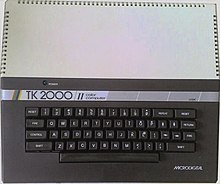Brazilian Apple II Plus clone made in 1984 by Microdigital Electrônica
TK 2000 TK 2000 II Color Computer |
| Also known as | TK 2000 Color Computer, TK 2000 II Color Computer |
|---|
| Manufacturer | Microdigital Eletrônica |
|---|
| Type | Personal computer |
|---|
| Release date | 1984; 41 years ago (1984) |
|---|
| Discontinued | 1987; 38 years ago (1987) |
|---|
| Operating system | Applesoft BASIC compatible, TKDOS 3.3 (Apple DOS 3.3 compatible) |
|---|
| CPU | MOS Technology 6502 @ 1,02 MHz |
|---|
| Memory | 64KB (expandable to 128KB) |
|---|
| Removable storage | Floppy Disks, Audio Cassette |
|---|
| Display | RF TV out or RGB; 40×24 text; 280×192 graphics; 8 colors |
|---|
| Sound | Beeper |
|---|
The TK 2000 microcomputer, produced by the Brazilian company Microdigital Eletrônica Ltda,[1][2][3] was presented to the public during the 1983 Computer Fair and launched in 1984.[4] It was a clone of the Microprofessor II manufactured by Multitech.[5][3] Based on the 6502 CPU, the machine was partially compatible with Apple II Plus software and hardware.[5][6] Some software was developed specifically for the machine, including productivity programs and games.[7][8]
In 1985 the TK2000/II was released and in 1987 the machine was discontinued.
Details
- CPU - MOS Technology 6502 at 1,02 MHz
- Memory - 16 KB ROM, 64 KB RAM (expandable to 128KB)
- Sound - one channel, up to 4 octaves with tones and semitones, 5 different tempos for each note, by software.
- Video - 280 x 192 with 8 colors, low-resolution mode emulates 16 colors through dithering.
- Keyboard - mechanical, 54 keys with QWERTY layout.
- Expansion - 1 slot
- Interfaces / Ports - TV output, RGB monitor, printer, joystick
- Storage - cassette recorder (1500 baud), external 5¼ floppy drive (140 Kb, double density)
- Operating system - BASIC, TKDOS 3.3 ( Apple DOS 3.3 compatible)
Models
TK 2000 Color Computer
This is the initial 1984 model.
TK 2000/II Color Computer
A 1985 rebranding of the initial model.[9][6][10]
TK 2000/II Color Computer 128Kb
This versions adds a 64KB memory expansion, totaling 128KB,[10] compatible with the Saturn memory expansion standard. Two hardware revisions of this model are known: TD112 with a satellite board, mounted next to the main board and connected to the main board via auxiliary wiring and TD122 with all components consolidated on a single board.
See also
References
